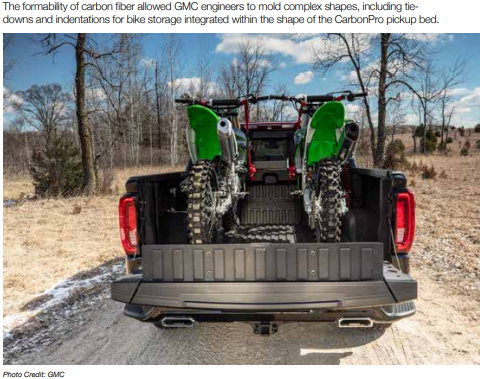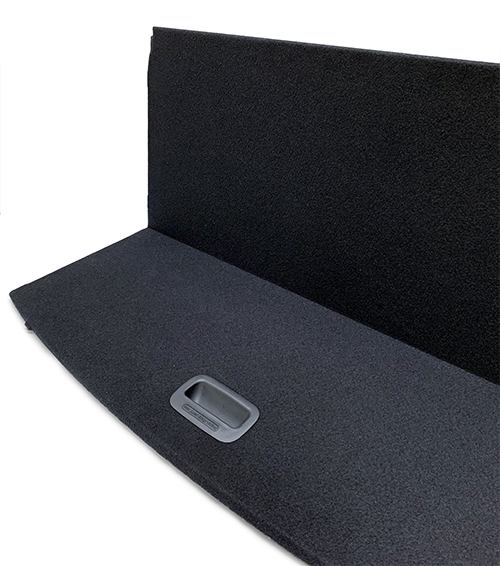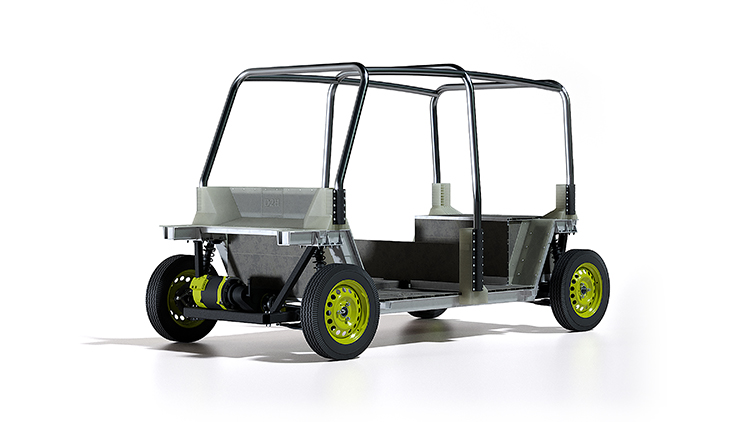

Pedal to the Metal
Lightweight composite materials have been a key part of developing more fuel-efficient vehicles, as data from the Department of Energy’s Vehicle Technologies Office indicates that a 10% reduction in vehicle weight can lead to a 6% to 8% improvement in fuel economy. However, as vehicle component manufacturers have found new ways to shave off weight, they’ve also learned to maximize composites’ other notable characteristics, including their tremendous strength and moldability.
But the tempting design freedom that CFRP and GFRP materials offer has been challenged by production scalability. That too is beginning to change. Developers are focusing on simplifying the number of components to assemble and reducing the need for secondary assembly or finishing to speed the entire manufacturing process at a more competitive cost.
That work seems to be paying off. Research firm Global Market Insights projects that the automotive composites market will grow at a compound annual growth rate of more than 6.7% from 2020 to 2026. Much of that growth will be due to work building off innovations now coming to market, such as the four composite applications profiled here.
Simplified Trunk Floor Production
The Hyundai Creta, India’s top-selling SUV, makes ample use of lightweight carbon fiber, from its front fender to the passenger seat cowl. However, it’s the SUV’s trunk floor that pushes the envelope in the use of composite materials.
When Brazil-based Tier 1 automotive supplier DPA Moldados began looking for a thermoplastic sandwich core solution to replace its previous thermoset option, it turned to EconCore, a specialist in thermoplastic honeycomb core technology, to help. Together, the material and component suppliers developed a compression molding process that replaces the conventional use of a multi-step thermoset polyurethane, glass fiber, paper honeycomb sandwich lay-up with a low-cost and environmentally-friendly thermoplastic honeycomb alternative.
In the past, such modular trunk floors were made out of two or three molded parts that were then connected into foldable sections with a hinge – yet another separate piece. With the new process, the supplier extrudes a thermoplastic material that is directly converted into the honeycomb core. The core is compression molded with thermoplastic glass fiber mat composite skins, all from a single sheet of sandwich preform, and the decorative thermoplastic carpets are added on the surface of the part at once. The hinge connecting the foldable sections is created in the same process by accommodating a mold gap design. The soft, preheated thermoplastic honeycomb core is calibrated into a “V” profile, creating a living hinge.
By reducing the need for secondary finishing, the supplier is able to speed production of this single part from a 90- to 120-second cycle to a 45- to 50-second cycle, a time savings that helps lower the overall cost of using a high-performance material.
Today, DPA sources the honeycomb core independently of the skins, but Tomasz Czarnecki, COO of EconCore, predicts that this process could be further streamlined by molding all panel components at a single location. “In the future, subject to high enough production volume, the compression molding step can be integrated with the continuous honeycomb sandwich panel production,” he says.
Czarnecki estimates that one high-capacity honeycomb line can create products for 10 or more different car models, a flexibility that adds to the solution’s overall value.
There’s one more notable benefit for the new Creta – a 20% reduction in weight by using the honeycomb trunk floor compared to the material used in earlier models. By using less material, the component reduces its weight and its impact on the environment. This part pushes environmental friendliness further as well.
“Our product, and the thermoplastic finishing carpets that automotive parts require for decorations, are recyclable,” Czarnecki explains. “Upon molding and integration of the carpets into the sandwich structure, they are not contaminated by other materials such as polyurethanes or thermoset glues, so at the end of the product’s life they can be fully recycled.” He adds that in certain cases, when the carpet and panel are made of the same thermoplastic material, the company can further simplify the recycling process and avoid any mechanical separation of components.
The production team is considering using ThermHex recycled PET thermoplastic honeycomb core in future iterations to further improve upon the product’s environmental friendliness.
CarbonPro Sees Mass Production
Rapid production speed is also a key benefit for the carbon fiber pickup bed first launched on General Motors’ 2019 Sierra Denali 1500 and Sierra AT4 1500, although that’s hardly been the focus of pickup enthusiasts. Advertising has focused on the fact that the lightweight CarbonPro box offers 10 times greater impact resistance than its steel counterparts, allowing it to stand up to hurricane Category 1 projectile testing. Early testing of the carbon fiber composite included dropping heavy loads, from cinder blocks to 450-pound water-filled steel drums, into the bed. The steel drums took a beating, but left little impact on the tough composite material.

Automotive component manufacturers, however, are more likely to be interested in the technology that supports high-volume production of this structural carbon fiber reinforced thermoplastic (CFRTP) component. The Japan-based composites technology supplier Teijin developed the production equipment to mold each CFRTP part in approximately one minute. An entire CarbonPro box – about 23 CFRTP pieces altogether – can be built in about 10 minutes. The boxes are assembled at Teijin subsidiary Continental Structural Plastics’ (CSP) Indiana facility.
Although GMC manufactured fewer than 500 of its roughly 200,000 2019 Sierras with the CarbonPro box, demand has pushed that number to closer to 20,000 in 2020, Automotive News reports.
Teijin’s proprietary, carbon fiber nylon thermoplastic material, Sereebo®, which makes up the CarbonPro headboard, wall and floor panels, offers more than just strength. It also reduces weight on the Sierra pickups by 25% compared to a traditional steel bed. Those weight savings add up further upon factoring in that the scratch- and dent-resistant bed eliminates the need for a 40-pound bed liner.
CFRTP’s formability allowed engineers to push out the sidewalls further, providing a full cubic foot more cargo room compared to a roll-formed steel bed. That moldability also presented GM with a unique level of design flexibility. GM engineers opted to mold into the box unique features, including tie-downs and indentations for bike storage, as well as a 3-dimensional “grain” to increase traction. In fact, as other automotive manufacturers are discovering, composites’ moldability presents a number of unique aesthetic and functional possibilities that simply aren’t possible with other materials.
Composite Engine Shroud Quiets Cabins
The moldability of composites helped Ford develop a unique solution to its noise challenge. Like other OEMs, Ford has a close eye on lightweighting opportunities, but it’s also focusing on the overall driving experience, including noise. Research on how to improve comfortability led the manufacturer to consider strategies for reducing powertrain noise, vibration and harshness (NVH) inside the vehicle cab. In fact, that’s the entire goal of the NVH Lab Ford launched in Dearborn, Mich.
The lab allows engineers to test vehicle sound in different settings, including a reverberation suite and a semi-anechoic chamber – a room where sound reflections only come from the floor, not the absorbent walls and ceilings – with powered rollers that simulate road noise. The semi-anechoic chamber provides an area free of echo and reverberation and creates a pure working environment for sound, while the reverberation suite is used to determine how noise permeates full components or materials, such as sheet metal. The lab also runs tests in temperatures ranging from -40 to 140 F to develop a stronger understanding of how material shrinkage and expansion may cause squeaks and rattles.
CSP was invited to the NVH lab as it worked with Ford to develop a thermoset sheet molding compound (SMC) for an engine shroud designed specifically to tackle the issue of noise and vibration. Ford had determined that separating the engine compartment from passengers with two walls could help reduce traveling sound in its 2020 Ford Explorer and Lincoln Aviator. The engine shroud mimics a semi-anechoic chamber similar to those used at Ford’s NVH testing lab.
CSP ultimately settled upon a vinyl ester-based SMC material with a high fiberglass content that it engineered using a compression molding process to meet the mass/density, NVH requirements, thermal properties and structural demands of the application. The resulting engine shroud creates an air gap between the engine compartment and the steel front bulkhead. It wraps around the back of the engine to meet the stabilizing strut towers on each side of the engine bay.
This form wouldn’t have been possible using traditional materials, says Bryan Ludwig, business development director at CSP. “Because our glass fiber composite is a thermoset, it actually offers better thermal properties than a metal and can be molded thin enough to fit in the tight spaces found in the engine compartment,” he explains.
Thermal protection is critical, as the engine shroud helps dismiss the excess heat generated by the engine to protect electrical components. Of course, by using a composite material like CSP’s proprietary material within one of those walls separating the engine from passengers, the manufacturer could also reduce the weight of adding additional components. At 12 pounds, the 4-piece assembly is lighter than a similar shroud stamped from steel.
Curving a Pultruded Bumper Beam
Chevrolet calls its 2020 Stingray the fastest, most powerful base model Corvette to date, capable of achieving 0 to 60 mph speed in under three seconds. It gets that speed in part from the expansive use of lightweight materials throughout its body. Much attention has been paid in the automotive industry press to the use of an ultra-lightweight float material used to fabricate the trunk tubs and dashboard. The float material is a fiberglass and proprietary resin SMC from Molded Fiber Glass Co. that’s reportedly so light it can float in water. However, the 2020 Stingray’s multi-hollow pultruded carbon fiber bumper beam demonstrates the strength that composite materials carry with that light weight.

Photo Credit: Ford
The shape of bumper beams play a role in their crashworthiness. Researchers with the University of Turin and Michigan State University have found that in composite bumper beam development, choice of curvature radius improves vehicle aerodynamics and architecture and can contribute to vehicle safety. Changing the material and beam curvature affect the stress distribution along the beam, as well as the stress values. Getting this change right provided Grand Haven, Mich.-based composite engineering firm Shape Corp. an opportunity to innovate.
Paul Roehm, product development engineer for advanced product development at Shape Corp., says the composite engineering company was already exploring advanced development efforts into pultrusion when approached by GM. The OEM was interested in using a composite solution to reduce the weight of the Stingray while meeting tough performance requirements.
The team ultimately chose a blend of carbon fiber and Scott Bader’s Crestapol® urethane acrylate resins to achieve the right balance of strength and lightweight properties for the bumper beam. In collaboration with Germany-based fiber composite pultrusion company Thomas Technik + Innovation, Shape engineers began prototyping pultruded profiles. The engineers started with straight profiles to develop an initial understanding of the manufacturing process and resulting product attributes before pushing for the industry’s first curved pultruded profile.

“In addition to the required quality and complexity of the targeted profile, with its multi-hollow design and thin walls, we also needed to be able to make the pultruded profile with curvature for our targeted application, something not done in the industry today,” explains Joe Matecki, Shape advanced product development product manager.
To create the curved profile, the engineering team had to rethink the standard pultrusion process. “In typical straight pultrusion, the grippers move to constantly pull the part,” explains Roehm. “To add curvature in thermosets, the part needs to be cured in a curved state.” The bumper beam production cell developed by Thomas Technik uses a curved, moving die to pull the part and a stationary gripper.
Photo Credit: EconCore
The finished bumper beam was to be bonded to the steel structure at the rear of the car, yet this presented another challenge. Several structural adhesives were tested to find the best combination of strength and toughness to meet the crash, impact and durability requirements necessary to achieve Chevrolet’s standards, as well as the high temperatures of the electrophoretic coating process, the finishing process used for steel components. To assemble the bumper beam on the manufacturing line, it had to withstand this tough primary finishing process. The team selected Crestabond® M7-05 in part due to its ability to bond under the high-temperature test protocol. Not only was the finished part able to achieve stringent Class A surfacing requirements, but it was able to do so on the primary manufacturing line.

SUBSCRIBE TO CM MAGAZINE
Composites Manufacturing Magazine is the official publication of the American Composites Manufacturers Association. Subscribe to get a free annual subscription to Composites Manufacturing Magazine and receive composites industry insights you can’t get anywhere else.




